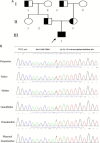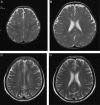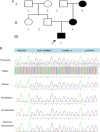A Study of Congenital Protein C Deficiency With Infancy Onset of CADASIL in a Chinese Baby
- PMID: 30883460
- PMCID: PMC6493701
- DOI: 10.1097/MPH.0000000000001436
A Study of Congenital Protein C Deficiency With Infancy Onset of CADASIL in a Chinese Baby
Abstract
Objective: The main objectives of this article were to study a severe congenital protein C deficiency (PCD) in a patient with cerebral autosomal dominant arteriopathy with subcortical infarcts and leukoencephalopathy (CADASIL) and analyze the cause of this case.
Materials and methods: We had recorded clinical manifestations of the patient, laboratory tests, imaging studies, and gene sequencing of the PROC gene and NOTCH3 gene to study the disease in this family. We checked the change of NOTCH3 protein by immunohistochemistry.
Results: Laboratory studies of the patient had revealed that his PC activity was 3%. Magnetic resonance imaging results showed hyperintense lesions in the cerebral white matter of the patient. PROC gene and NOTCH3 gene sequencing was performed among the family members. The patient was confirmed as homozygous for the (A-G)-12 at the transcription initiation site in the promoter region of the PROC gene and heterozygous mutation of the NOTCH3 gene. Immunohistochemical results showed that NOTCH3 protein was positive in the skin vascular smooth muscle of the patient.
Conclusions: We studied a rare case of an infat boy diagnosed with both congenital PCD and CADASIL; congenital PCD was attributable to a compound that was homozygous for (A-G)-12 at the transcription initiation site in the promoter region of the PROC gene, and CADASIL was caused by missense mutation in exon 24 of NOTCH3. He was a sporadic patient with congenital PCD and CADASIL; it maybe that the deficiency of protein C led to early onset of CADASIL. The gene sequencing of PROC gene and NOTCH3 gene may have important value for fertility guidance and prenatal diagnosis.
Conflict of interest statement
The authors declare no conflict of interest.
Figures




Similar articles
-
Homozygous NOTCH3 p.R587C mutation in Chinese patients with CADASIL: a case report.BMC Neurol. 2020 Mar 2;20(1):72. doi: 10.1186/s12883-020-01660-0. BMC Neurol. 2020. PMID: 32122318 Free PMC article.
-
Renal involvement in cerebral autosomal dominant arteriopathy with subcortical infarcts and leukoencephalopathy (CADASIL).Clin Nephrol. 2007 Mar;67(3):182-7. doi: 10.5414/cnp67182. Clin Nephrol. 2007. PMID: 17390743
-
A Japanese Case of CADASIL with a Rare Mutation in Exon 24 of the NOTCH3 Gene.Intern Med. 2018 Oct 15;57(20):3011-3014. doi: 10.2169/internalmedicine.0723-17. Epub 2018 May 18. Intern Med. 2018. PMID: 29780132 Free PMC article.
-
A Novel Heterozygous Variant in Exon 19 of NOTCH3 in a Saudi Family with Cerebral Autosomal Dominant Arteriopathy with Subcortical Infarcts and Leukoencephalopathy.J Stroke Cerebrovasc Dis. 2020 Jul;29(7):104832. doi: 10.1016/j.jstrokecerebrovasdis.2020.104832. Epub 2020 May 13. J Stroke Cerebrovasc Dis. 2020. PMID: 32414585 Review.
-
[Cerebral autosomal dominant arteriopathy with subcortical infarcts and leukoencephalopathy (CADASIL)].Rinsho Byori. 2009 Mar;57(3):242-51. Rinsho Byori. 2009. PMID: 19363995 Review. Japanese.
References
-
- Hepner M, Karlaftis V. Protein C. Methods Mol Biol. 2013;992:365–372. - PubMed
-
- Stenflo J. A new vitamin K-dependent protein: purification from bovine plasma and preliminary characterization. J Biol Chem. 1976;251:355–363. - PubMed
-
- Cooper PC, Hill M, Maclean RM. The phenotypic and genetic assessment of protein C deficiency. Int J Lab Hematol. 2012;34:336–346. - PubMed
-
- Koster T, Rosendaal FR, Brie¨t E, et al. Protein C deficiency in a controlled series of unselected outpatients: aninfrequent but clear risk factor for venous thrombosis (Leiden Thrombophilia Study). Blood. 1995;85:2756–2761. - PubMed
Publication types
MeSH terms
LinkOut - more resources
Full Text Sources
Miscellaneous

